|
Related FAQs: Anemones,
Anemones 2, Anemones
3, Anemones 4, Anemones 5, Anemones 6, LTAs,
Bubble
Tip Anemones, Caribbean
Anemones, Condylactis, Anemones & Clownfishes,
Anemones & Clowns 2,
Anemone
Identification, Anemone ID
2, Anemone ID 3, Anemone ID 4, Anemone ID 5, Anemone ID 6, Anemone ID 7, Anemone ID 8,
Anemone ID
9, Anemone
ID 10, Anemone ID 11, Anemone ID 12, Anemone ID 13, Anemone ID 14, Anemone ID 15, Anemone ID 16 Anemone ID 17, Anemone ID 18, Anemone ID 19, Anemone ID 20, Anemone ID 21, Anemone ID 22, Anemone ID 23, Anemone ID 24, Anemone ID 25, Anemone ID 26, Anemone ID 27, Anemone ID 28, Anemone ID 29, Anemone
ID 30, Anemone ID 31, Anemone ID 32, Anemone ID 33, Anemone ID 34, Anemone ID 35,Anemone
ID 36, Anemone ID 37, Anemone ID 38, Anemone ID 39, Anemone ID 40, Anemone ID 41, & Anemone Behavior,
Anemone Behavior
2, Anemone Compatibility, Anemone Compatibility 2, Anemone
Selection, Anemone
Health, Anemone Health
2, Anemone Health 3, Anemone Health 4, Anemone Health 5, Anemone Health 6, Anemone Health 7, Anemone Health 8, Anemone Health 9, & Anemone
Placement, Anemone
Reproduction, Anemone Systems
1, Anemone Systems 2, Anemone Systems 3, Anemone
Lighting, Anemone Lighting
2, Anemone Lighting 3,
Anemone Lighting 4, Anemone
Feeding, Anemone Feeding 2,
Aiptasia, Other Pest
Anemones, Heteractis malu,
Related Articles: Heteractis
crispa/Sebae Anemones, Magnificent
Anemones, Heteractis malu, Invertebrates, Stinging-Celled Animals, Clownfishes, Coldwater Anemones, Bubble
Tip Anemones, Aiptasia/Glass
Anemones, Anemones of
the Tropical West Atlantic, Colored/Dyed Anemones, Marine Light, &
Lighting, Water
Flow, How Much is Enough,
/Diversity of Aquatic Life
Series
Anemones in
Captive Systems
Part 2 of
3
Part 1,
Part 3,
|

|
|
By Bob Fenner
|
Actinodendron sp.
|
 |
New Print and
eBook on Amazon:
Anemone Success
Doing what it takes to keep Anemones healthy long-term
by Robert (Bob) Fenner
|
Other Anemones in the Wild and
Hobby:
Family Actiniidae:
| Condylactis
species. Though most of these come to use from the tropical
West Atlantic as inexpensive "Condys", there are
Indo-Pacific species. This one in Fiji. |
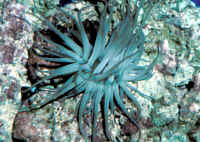
|
Family Actinodendronidae:
| Actineria sp. N. Sulawesi. |
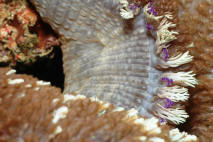 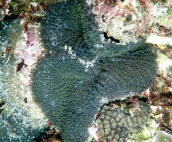
|
Bigger PIX:
The images in this table are
linked to large (desktop size) copies. Click on "framed"
images to go to the larger size. |
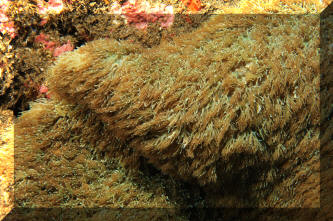
%20MD.JPG) |
Bigger PIX:
The images in this table are linked
to large (desktop size) copies. Click on "framed" images
to go to the larger size. |
|
|
Actinodendron arboreum (Quoy & Gaimard 1833).
Hellfire Anemone (DO NOT TOUCH). /Wiki:
The oral disc of Actinodendron
arboreum has
stripes that radiate from the mouth, and can reach a diameter of 10 to 20
centimetres.[7] The
column is elongated when expanded; it has a fairly small pedal disc and is
thicker at the distal (upper) end. The tentacles are colourless, around 10
to 20 centimetres long and ramify fractally, being subdivided into branches
and branchlets which makes the whole head of tentacles resemble a broccoli.
The tentacles grow in whorls as the animal enlarges; the first whorl is six
tentacles followed by further whorls of six, twelve and twenty-four
tentacles. The first and third whorls of tentacles are endocoelic (set
between the mesenteries in
the column interior) and the second and fourth are attached marginally. The
sea anemone is well-armed with cnidocytes which
are of varying lengths, the ones in the central region of the tentacles
being least variable. A juv. in
N. Sulawesi, Indo. |
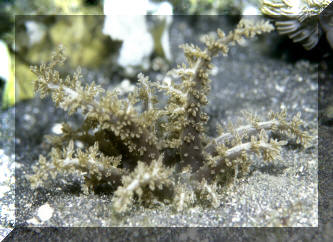
|
| Actinodendron cf. glomeratum Haddon 1898,
Branching Anemone. Low-lying bush-like anemone. Distinctive knobby
vesicles on flattened tentacles. Generally greenish in color, open
during the day, occurring in sand/mud. Western Pacific; Australia,
Philippines. N. Sulawesi pic at night (note Sexy Shrimp at base
under sponge). |
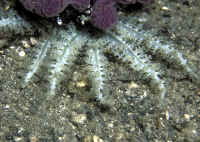
|
Bigger PIX:
The images in this table are
linked to large (desktop size) copies. Click on "framed"
images to go to the larger size. |
MD.jpg)
/Thor/DSC_1684%20crop%20thor%20amboinensis%20LeytePI%20%20(2)%20MD.jpg)
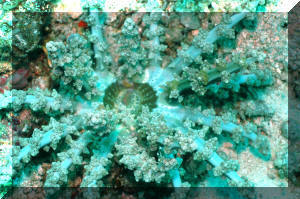
%20MD.JPG)
|
| Actinodendron cf. plumosum Haddon 1898. Branching Anemone. Bali
2014 |
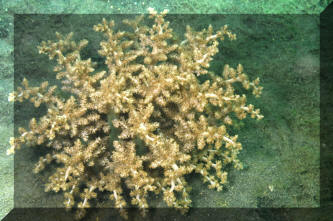
|
| Actinodendron sp. N. Sulawesi. |
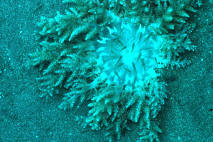
|
Bigger PIX:
The images in this table are
linked to large (desktop size) copies. Click on "framed"
images to go to the larger size. |
MD.jpg)
MD.jpg)
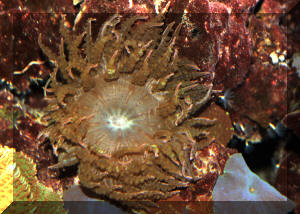 |
| Actinostephanus haeckeli Kwieniewski 1827.
Have 12 or more snake-like tentacles originating from a flattened
oral disc. Prominent yellow tubercles on reddish arms. Active at
night on mud/sandy bottoms. Western Pacific; Indonesia,
Philippines. N. Sulawesi pix. |
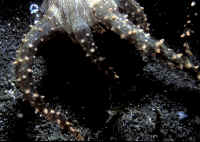 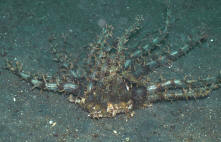
|
Bigger PIX:
The images in this table are
linked to large (desktop size) copies. Click on "framed"
images to go to the larger size. |
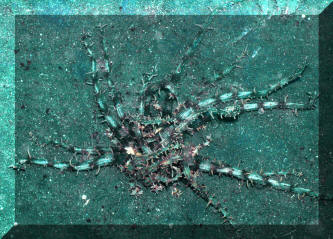 |
| Megalactis sp? Branching anemone. N.
Sulawesi pix. |
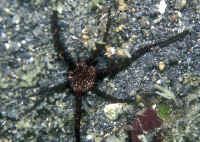
|
Bigger PIX:
The images in this table are linked
to large (desktop size) copies. Click on "framed" images
to go to the larger size. |
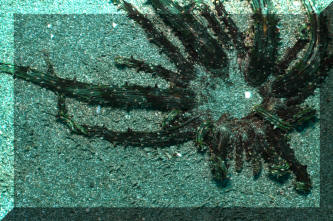 |
Family Aiptasiidae:
| Bellactis caeruleus,
These two are pix from Roatan; the first by TiffB in 2016, the second by
SaraL 2019.
Tentative ID by Joe Fish via Facebook posting. |

%20MD.JPG) |
Family Aliciidae:
Triactis producta Klunzinger 1877. Indo-Pacific; Red Sea, East Africa to
Hawaii and Fr. Polynesia. Small; about 10 mm basal disc diam., and 15 mm.
column hgt. Often colonial, found amongst or living on stony coral. Pix here
during the daytime in the upper Sinai, Red Sea, showing pseudotentacles and
vesicles (spherical bumps). Open at night with feeding tentacles. One
anemone species used by Lybia/Pom Pom, boxing crabs. ID by Ron Silver via Facebook posting.
https://www.floridamuseum.ufl.edu/iz/2013/07/07/triactis-producta/ |
%20MD.JPG)
%20MD.JPG) |
Family Edwardsiidae:
| Edwardsiana pudica (Klunzinger 1877) poss.
Sea anemone. N. Sulawesi pic. |
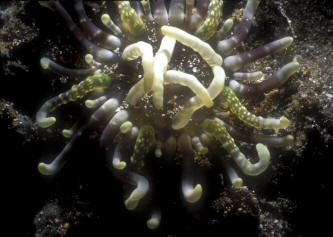 |
Bigger PIX:
The images in this table are
linked to large (desktop size) copies. Click on "framed"
images to go to the larger size. |
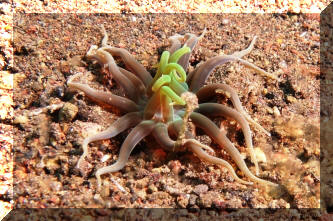
%20MD.JPG) |
Family Hormathiidae:
| Amphianthus sp? Colonial anemone. N.
Sulawesi pic. |
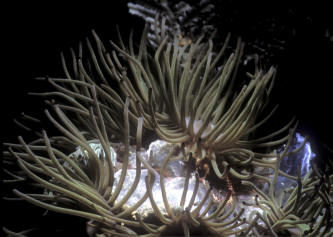
|
F amily Nemanthidae:
|
Nemanthus annamensis Colonial anemone, called the Gorgonian Wrapper.
Bali 2014 |
%20MD.JPG)
|
F amily Phymanthidae:
| Phymanthus sp. (poss. P. loligo),
Somo Somo St., Taveuni,
Fiji. |
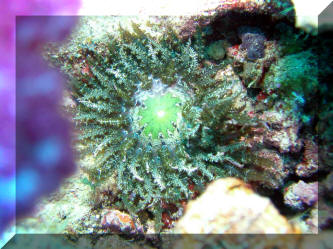
|
Where are other Tropical West Atlantic
Anemones?
About " Colored
Anemones":
| Yes, sad to state, there are such things... dealers
in the orient use chemical dyes to stain mainly "Sebae"
(Heteractis crispa) anemones various colors... even country's
flag emblems... Sigh, no, the color doesn't last, and I
strongly suspect it detracts from their health. Shown, an
artificially colored H. crispa and "Sebae" (Clarkii)
Clownfish. |
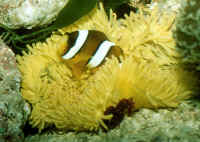
|
To: Part
1, Part
3,
|
|

